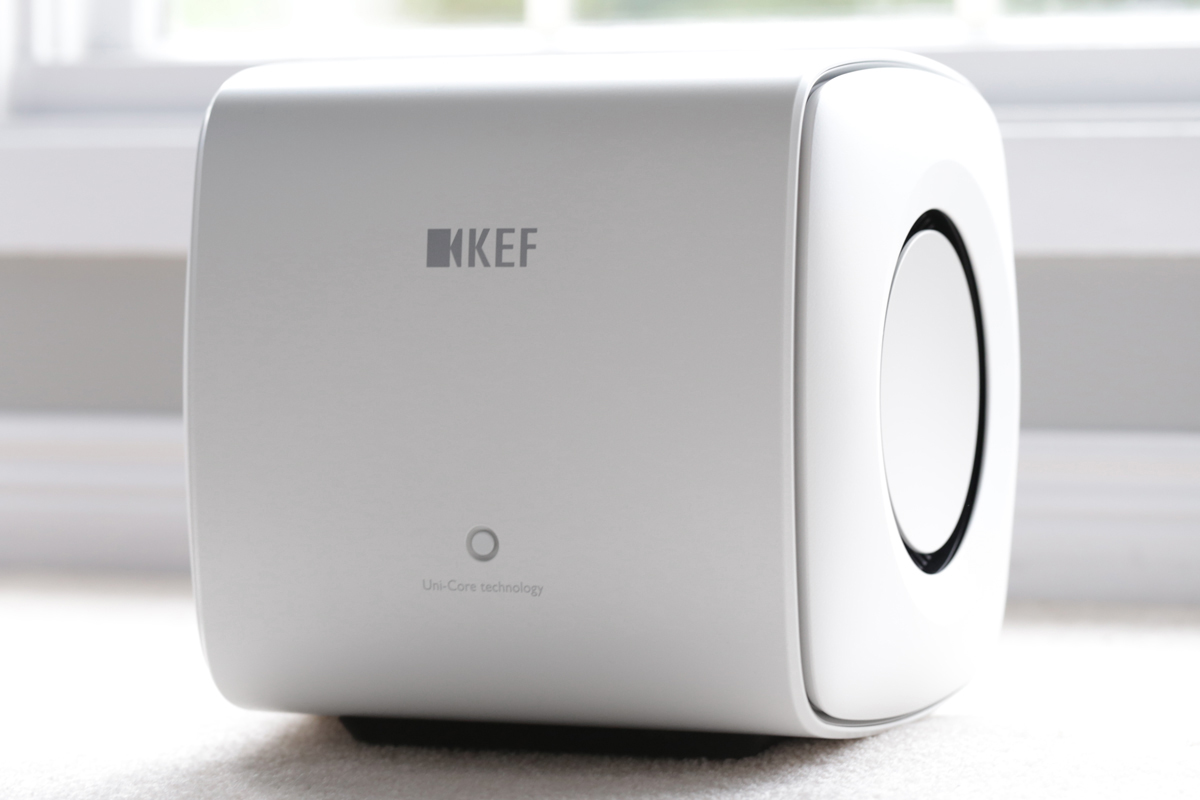 Here’s a bit of audio trivia for your holiday enjoyment: Who was J.A. Hofmann? If you’ve been into audio as long as I have, you’ll know him as the H in the loudspeaker brand KLH. Along with Henry Kloss and Malcolm S. Low, Hofmann was a founding partner of KLH Research and Development Corporation, which was formed in 1957, and has recently been revived as KLH Audio.
Here’s a bit of audio trivia for your holiday enjoyment: Who was J.A. Hofmann? If you’ve been into audio as long as I have, you’ll know him as the H in the loudspeaker brand KLH. Along with Henry Kloss and Malcolm S. Low, Hofmann was a founding partner of KLH Research and Development Corporation, which was formed in 1957, and has recently been revived as KLH Audio.
Josef Anton “Tony” Hofmann is also famous for Hofmann’s Iron Law. This states that low-bass reproduction, small enclosure size, and high output sensitivity cannot ALL be achieved in a single loudspeaker design.
KEF cites Hofmann’s Iron Law in the white paper for its new super-small KC62 subwoofer ($1499.99, all prices in USD), the subject of this review. KEF says its aim in designing the KC62 was “to push . . . Hofmann’s Iron Law to its limits,” so it could achieve “high output, low extension and small cabinet size. . . . Iron Laws cannot be broken, but they can certainly be bent.”
Bent how far? A whole lot, judging by KEF’s specs for the KC62. Specified frequency response is 11–200Hz, ±3dB, and maximum output is 105dB. All this from a 10″ cube!
KEF cites four reasons why people might want a tiny sub like the KC62: for use in smaller listening areas; for placement in multipurpose spaces like living rooms; aesthetics; and to accommodate multiple subwoofers. Two of these—aesthetics and use in multipurpose spaces—are near and dear to this reviewer’s heart. The KC62 seems tailor-made for Simplifi’d hi-fi.
Inside . . .
As soon as you pick up the KC62, you realize that there’s a lot of heavy stuff packed into that tiny enclosure. The KC62 measures 10.1″W × 9.7″H × 9.8″D, including the rear panel and feet, but tips the scales at nearly 31 pounds. It’s like picking up a boulder or a concrete block.
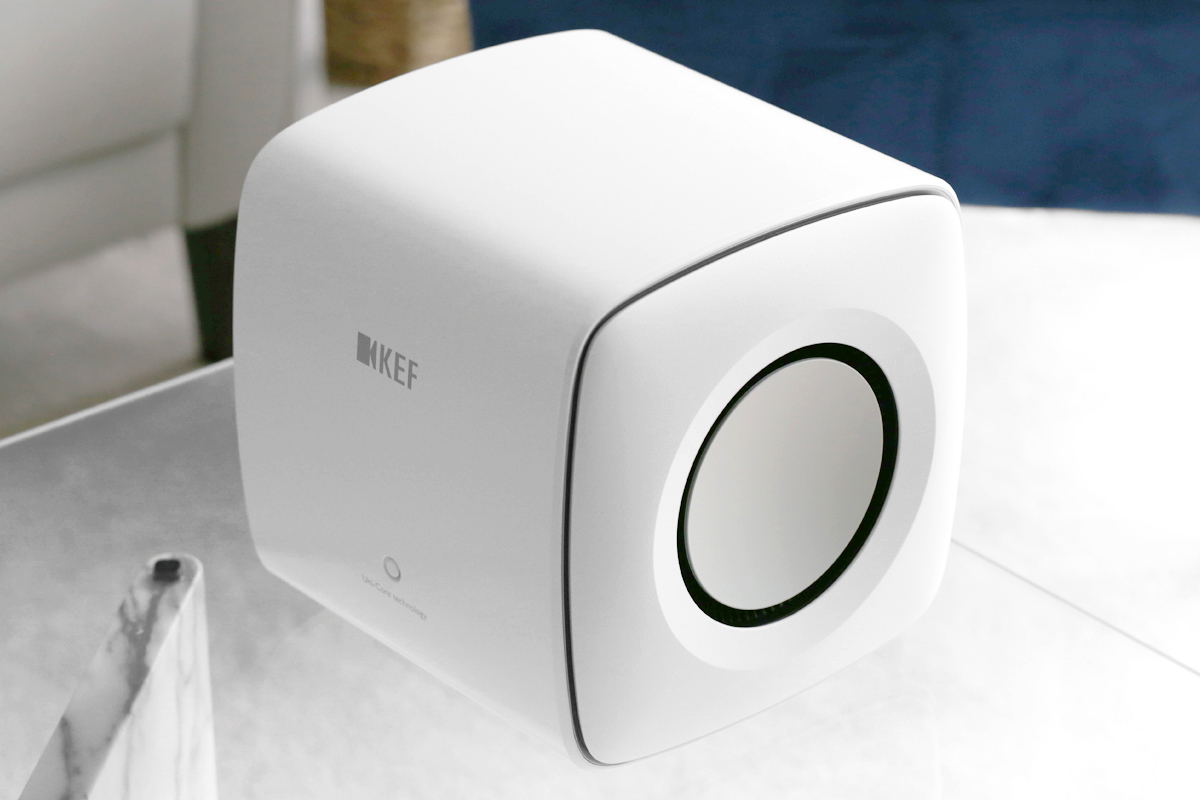
No surprise there. If you’re going to build a tiny subwoofer that goes down to 11Hz and blasts out 105dB, you need some serious iron. And silicon. And brain power. Earlier this year in a SoundStage! InSight video, KEF’s VP of technology Dr. Jack Oclee-Brown and R&D engineer David Bosch outlined some of the technology inside the KC62.
The KC62’s biggest innovation is its Uni-Core array. Two 6.5″ aluminum woofers, each powered by a 500W class-D amp, are mounted on opposite sides of the sealed enclosure in a force-canceling configuration. As Oclee-Brown explained, “the force applied to each of the cones is equal and opposite, which means the reaction force on the motor is also equal and opposite. . . . You get a much lower level of cabinet vibration compared to a normal subwoofer.”
The KC62 does not use two separate drivers. “Although you see two cones from the outside, inside there’s one combined motor for both units,” Oclee-Brown said. This allows internal volume to be reduced by one-third, and also allows longer cone excursions for higher output.
The two drivers have concentric voice coils of different diameters, each operating in its own voice-coil gap. The Uni-Core driver “requires a lot of optimization of the motor structure in order for the two drivers to behave the same, having different voice coils,” Bosch noted.
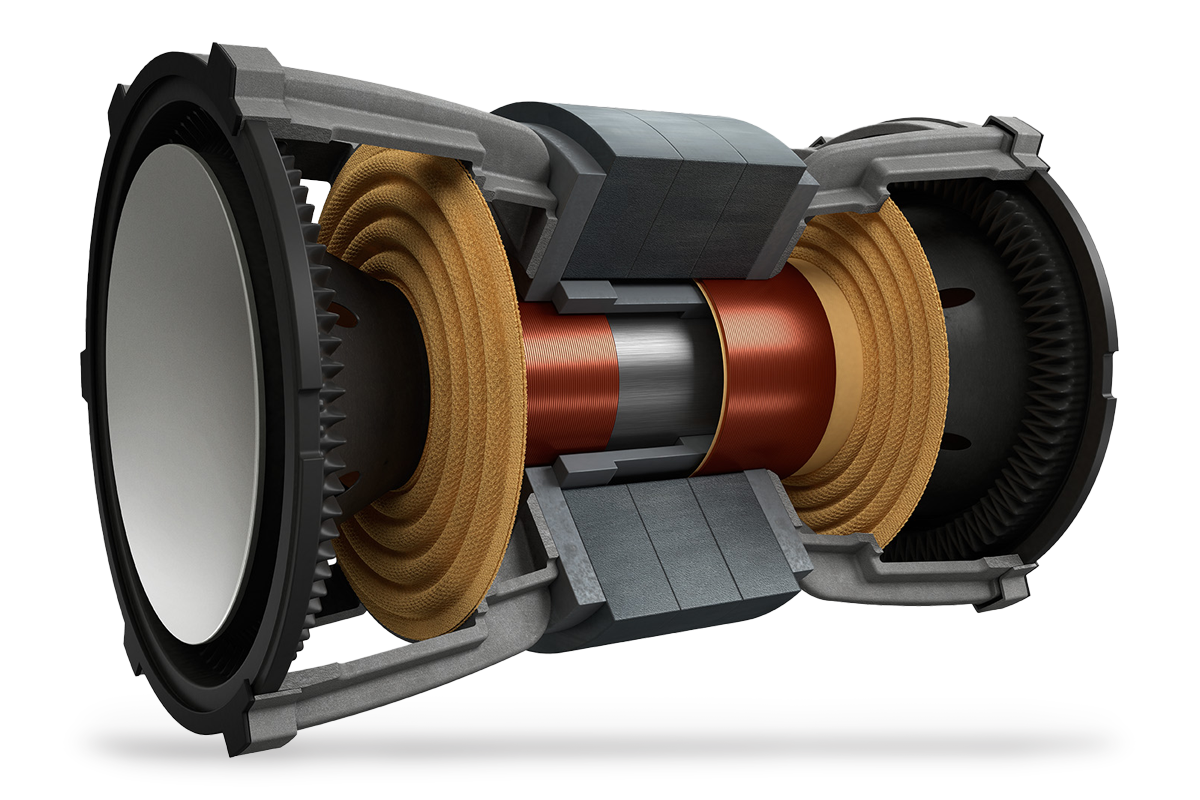
KEF also developed a new driver surround that could withstand the enormous pressures that build inside the small enclosure. “We tried a conventional surround,” Oclee-Brown said. “It didn’t work. The pressure collapsed the surround, and the performance was quite disappointing.” The KC62’s pleated P-Flex surround “can withstand much higher pressure from the high excursion of two drivers in a really small enclosure,” Bosch added.
The KC62’s curvaceous extruded-aluminum cabinet has two major benefits. As Oclee-Brown noted, it resists flexing caused by air pressure within the enclosure, and also dissipates heat from the two 500W amplifiers.
The KC62’s DSP applies pre-compensation for non-linearities based on a mathematical model of the Uni-Core driver’s behavior. At the same time, it monitors cone motion based on current in the voice coils, and uses this information to apply feedback to cancel distortion.
. . . and out
The KC62 is a pretty little subwoofer. My review sample sported the Mineral White finish; a Carbon Black finish is also available. The top and bottom edges, at both the front and back, are curved. The Carbon Black version has black driver cones and black surrounds; the Mineral White version has silver-gray cones and black surrounds. Both versions have black trim rings surrounding the side panels.
At the top center of the front panel is a gray KEF badge, and in the bottom center, a “Uni-Core technology” badge—both are tastefully understated. Above the Uni-Core badge is an indicator LED that glows amber when the sub is in standby, and white when it wakes up and starts playing—the indicator shuts off after six seconds.
The subwoofer has two rows of inputs and controls on its rear panel. On the lower left is the main power switch and next to it a three-prong IEC power inlet. The Volume control is in the upper-right corner.
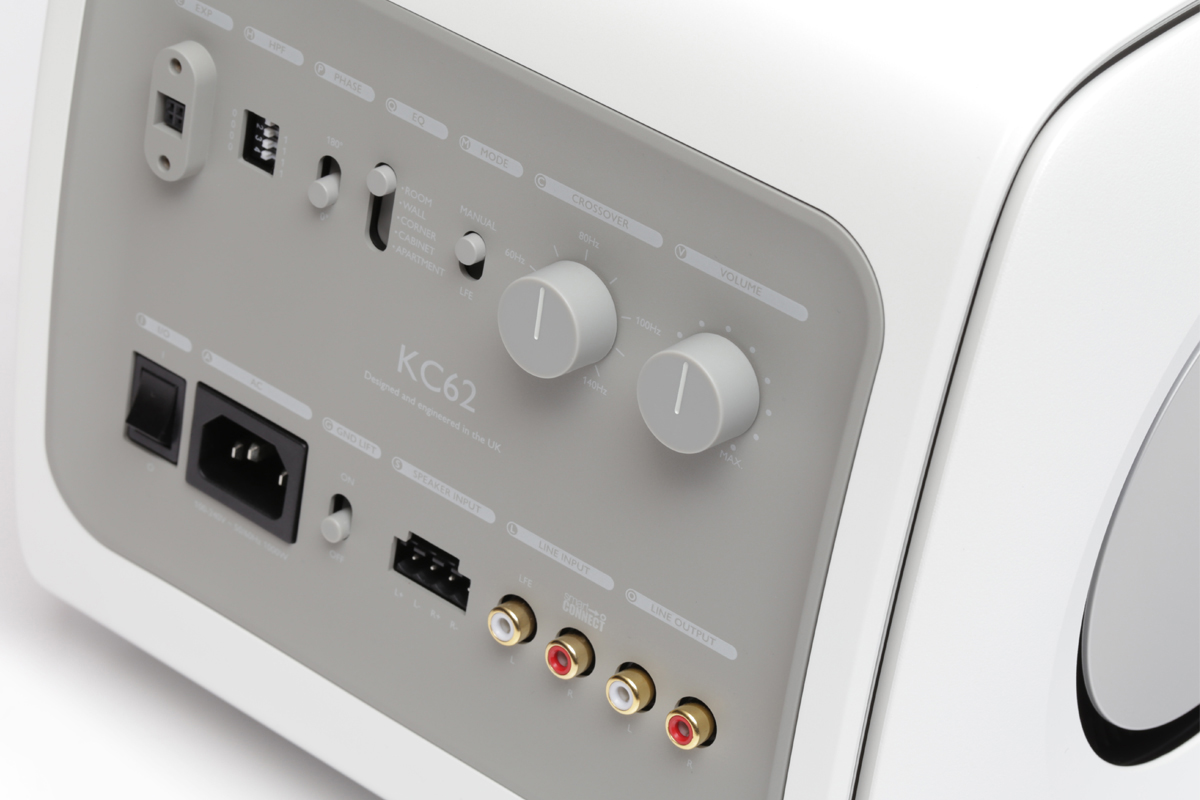
A glance at the rear panel and a quick read of the User Manual (which is a little cryptic, but covers the basics) confirms that there are many ways to use the KC62.
You can connect the pair of RCA line-level inputs on the KC62 to the line-level outputs of an integrated amp or preamp. For this application, you set the Mode switch to Manual, and set the low-pass filter frequency for the sub with the Crossover control, which is adjustable from 40 to 140Hz.
You can connect the left RCA input, which is labeled “LFE” (low-frequency effects), to the subwoofer output of a surround-sound receiver, or other component with bass management. For this application you set the Mode switch to LFE—the source component will implement the low-pass filter for the sub.
If you have an amplifier without preamp or subwoofer outputs, you can connect its speaker outputs to a custom connector that’s supplied with the KC62—that connector fits into the Speaker Input block on the bottom row. For this application, set the Mode switch to Manual, and choose a value for the low-pass filter with the Crossover control.
In the upper-left corner is a connector labeled “Exp,” for use with the KEF’s optional KW1 wireless subwoofer adapter kit ($199.99). Connect the receiver to the KC62’s Exp port, and the transmitter to the subwoofer or preamp outputs of the source component. If the source component has bass management, set the Mode switch in the LFE position. If the source component outputs full-bandwidth audio, set the Mode switch to Manual, and set the low-pass filter frequency with the Crossover control.
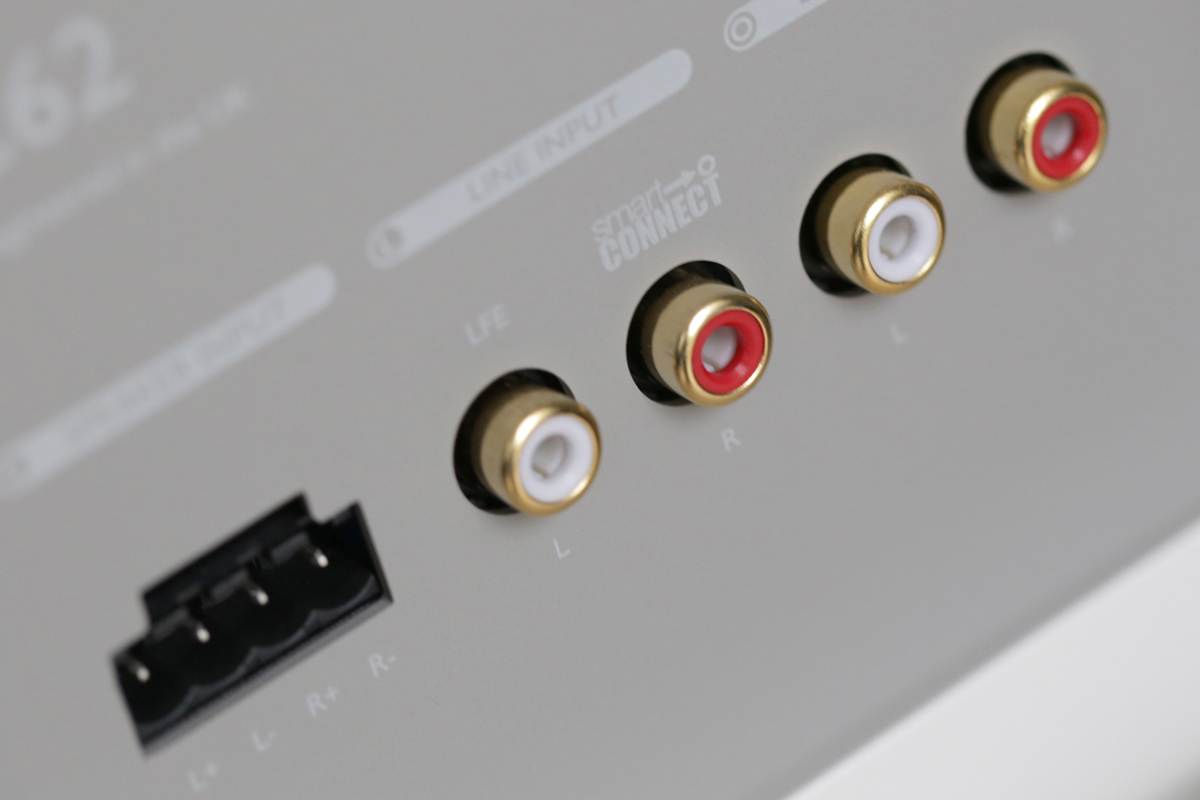
The KC62 also has line-level outputs. These can be used for sending audio to a second subwoofer or sending full-range audio to an amp or preamp. In the latter application, you can apply a high-pass filter using four DIP switches in a block labeled “HPF” to the right of the Exp port. This is a very useful feature—if you use this option, your main speakers don’t have to handle deep bass.
Other controls include a two-position phase switch (use the 0° setting if the sub is located close to the main speakers, 180° if it’s far away), and a Gnd Lift switch (turn it on if you’re hearing hum through the sub; otherwise leave it off).
Finally, there’s a very useful five-position EQ switch for placement away from room boundaries (the Room setting), next to a wall, in a corner, or inside a cabinet. The fifth setting is Apartment, which reduces the level of very low frequencies so those sounds don’t travel to adjacent dwellings.
Setup I
For my first round of listening, I connected the KC62 to the subwoofer outputs of my NAD C 658 streaming DAC-preamp ($1749), whose balanced outputs were connected to the XLR inputs on my Elac Navis ARF-51 active floorstanding speakers ($5399.96/pair). The speakers were 18″ from the wall behind them, 7′ apart, and 7′ from the sweet spot on the end cushion of the sectional sofa on the opposite wall.
The ARF-51 employs three 5.25″ aluminum-cone woofers powered by a 160W BASH amplifier, and a midrange-tweeter comprising a 4″ aluminum-cone midrange and concentrically mounted 1″ soft-dome tweeter. The midrange driver is powered by a 100W BASH amplifier and the tweeter by a 40W class-AB amp. Specified frequency response is 43Hz–28kHz.
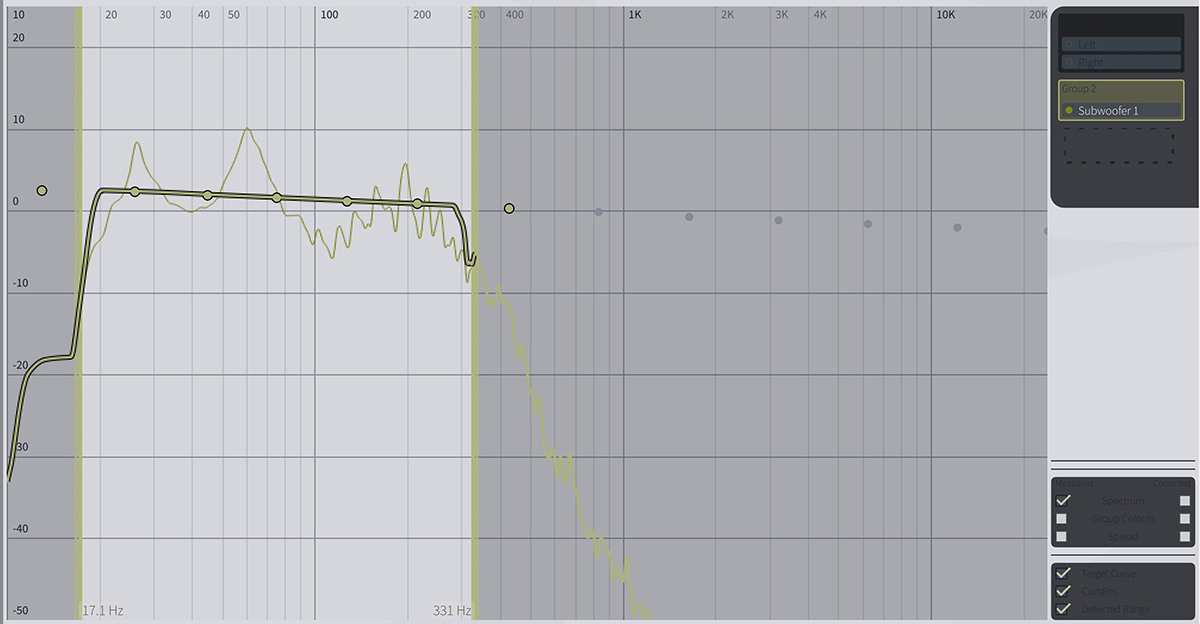
I placed the KC62 against the front wall, just to the left of the right speaker, and 3′ from the sidewall to the right. Per the manual, I set the EQ switch to the Wall position. After setting the subwoofer to LFE mode, I played a series of sine-wave test tones to help me set the KC62’s output volume, so that it matched the Navis speakers—I ended up setting the Volume control to approximately 11 o’clock. Then I ran the Dirac Live room correction app on my HP Spectre Windows laptop.
I used the Dirac feature on my C 658 for two reasons: to hear the KEF subwoofer free of the peaks and dips caused by room modes in my living room, and to see the in-room response reported by Dirac. Dirac’s corrected curve showed flat output down to 20Hz, with a -10dB point of 17.1Hz for the KC62 in my living room.
Listening I
Now it was time to listen. I started with one of my favorite tracks for assessing bass performance: the title track from Flight of the Cosmic Hippo (16-bit/44.1kHz FLAC, Warner Bros. Records/Qobuz), by Béla Fleck and the Flecktones. On this track, Victor Lemonte Wooten plays a five-string electric bass guitar whose bottom string is tuned to B0—at 30.87Hz, that’s about 10Hz lower than E1, the lowest note on a four-string bass.
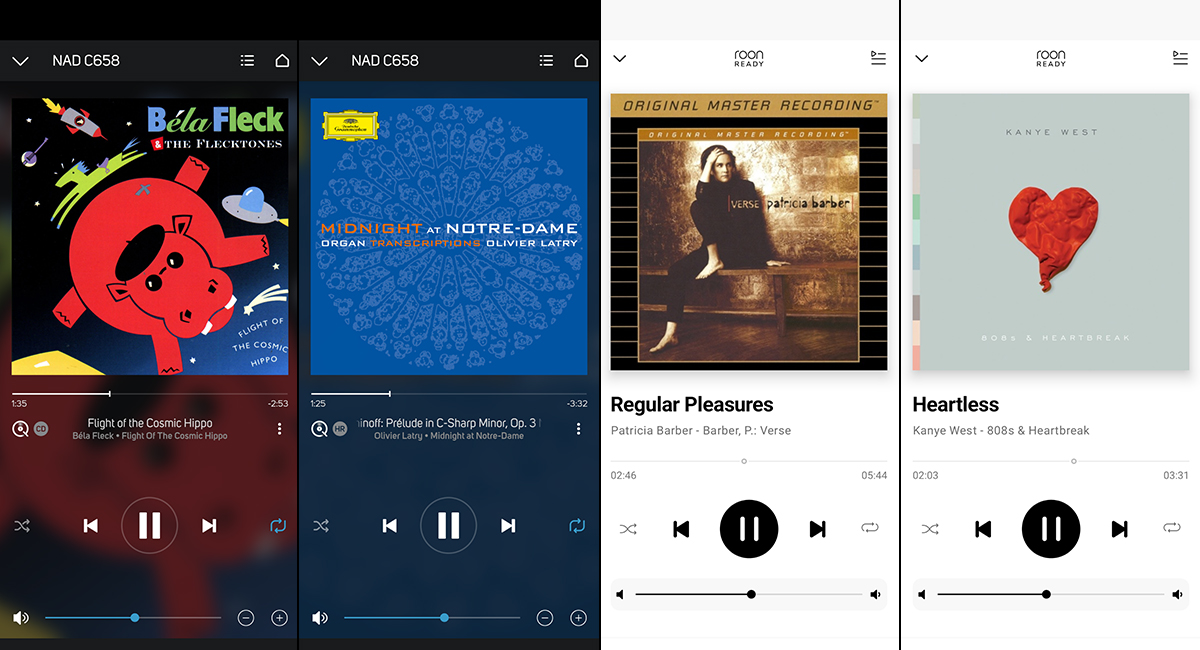
The track opens with a big, lumbering bass riff meant to evoke the awkward gait of the song’s subject; and, in the middle of the track, Victor Wooten plays much of the latter part of a lengthy bass solo on the instrument’s bottom string. While there’s nothing subterranean here, there’s loads of snappy, high-impact bass from 30Hz up.
I started listening with the KC62 turned off, with a Dirac room-correction setting I’d implemented for the Elac floorstanders sans subwoofer. Lows were satisfying through the Navis speakers on their own. But the bottom notes of Victor Wooten’s five-string bass were slightly fainter than notes played on higher strings—I could sense the Elacs starting to run out of gas as he plumbed the lowest depths of his instrument.
Next, I powered up the KC62 and enabled the Dirac Live setting I had created for the Navis speakers plus the KEF sub. With the KC62 filling in the bottom octave, Victor Wooten’s bass had much more slam—the big bass note that opens the track just jumped into my room. It was larger and more powerful, and also crisper and better defined. The same was true of the bass solo in the middle of the track. As you’d expect, the difference was most pronounced on notes played on the bottom string. Those notes sounded completely effortless, and had more texture and better pitch differentiation with the KC62 in the mix. I was much more aware of the tremolo effects Victor Wooten adds in the second part of his bass solo, played on the lowest string.
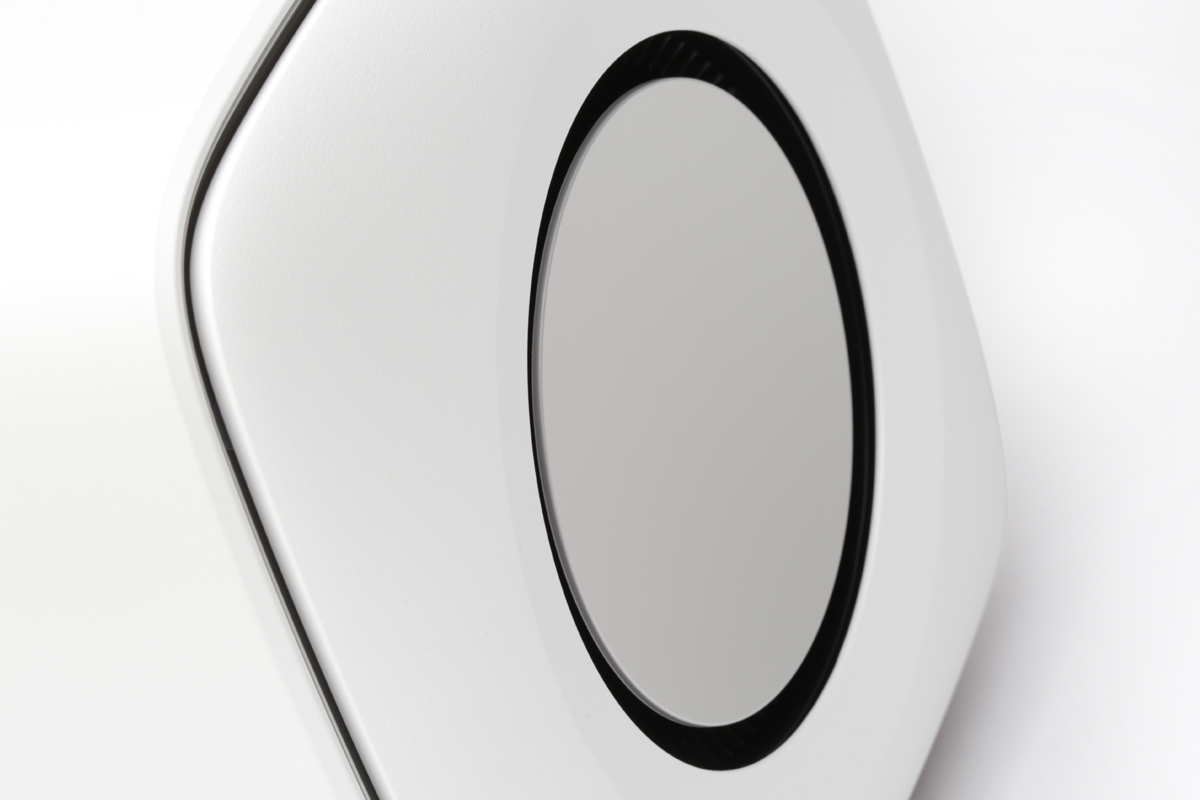
And Roy “Future Man” Wooten’s synthesized kick-drum beats hit harder. With the KC62 playing, I could feel as well as hear those beats. But the five-string bass and synthesized drums never sounded at all bloated—a testament to both the KC62 sub and the C 658’s Dirac Live processing. The whole presentation felt bigger, livelier, and more transparent. With the sub playing, the soundstage was slightly deeper and quite a bit higher.
Whenever I’m reviewing a subwoofer, I like to hear some pipe organ music with deep pedal notes, so I cued up Louis Vierne’s transcription for organ of Sergei Rachmaninoff’s brooding Prelude in C Sharp Minor for piano, as performed by Olivier Latry on his 2004 album Midnight at Notre-Dame (24/96 FLAC, Deutsche Grammophon/Qobuz). Rebuilt by the famed 19th-century organ builder Aristide Cavaillé-Coll using pipework from earlier instruments, the grand organ in Paris’s Notre-Dame Cathedral has 32′ pipes that sound down to C0 (16.35Hz). I don’t know if the pedal notes that Latry plays for most of this piece reach as low as that subterranean C, but if they don’t, they get mighty close. There’s lots going on below 40Hz on this track.
Through the Elac mains alone, those deep pedal notes were faint—not quite missing in action, but almost. Although the notes were faint, they were well defined with good pitch differentiation. I suspect I was mainly hearing harmonics without the fundamentals. I missed the deep growl and the sense of pulsating air that you get with very deep pedal notes from such a big instrument.
That all changed when I switched on the KC62 and chose the Dirac setting I had created for it with the Elacs. With the KC62 filling in the bottom octaves, those pedal notes filled my listening room. While the very deepest notes didn’t sound quite as loud as those pitched a little higher, that may have been because they were approaching the low-frequency limits of this little subwoofer, or, more likely, because they were approaching the threshold of audibility. But those notes had a convincing deep growl. I could sense the air in my living room throbbing as Latry played the lowest notes, and I could feel them in my legs and torso.
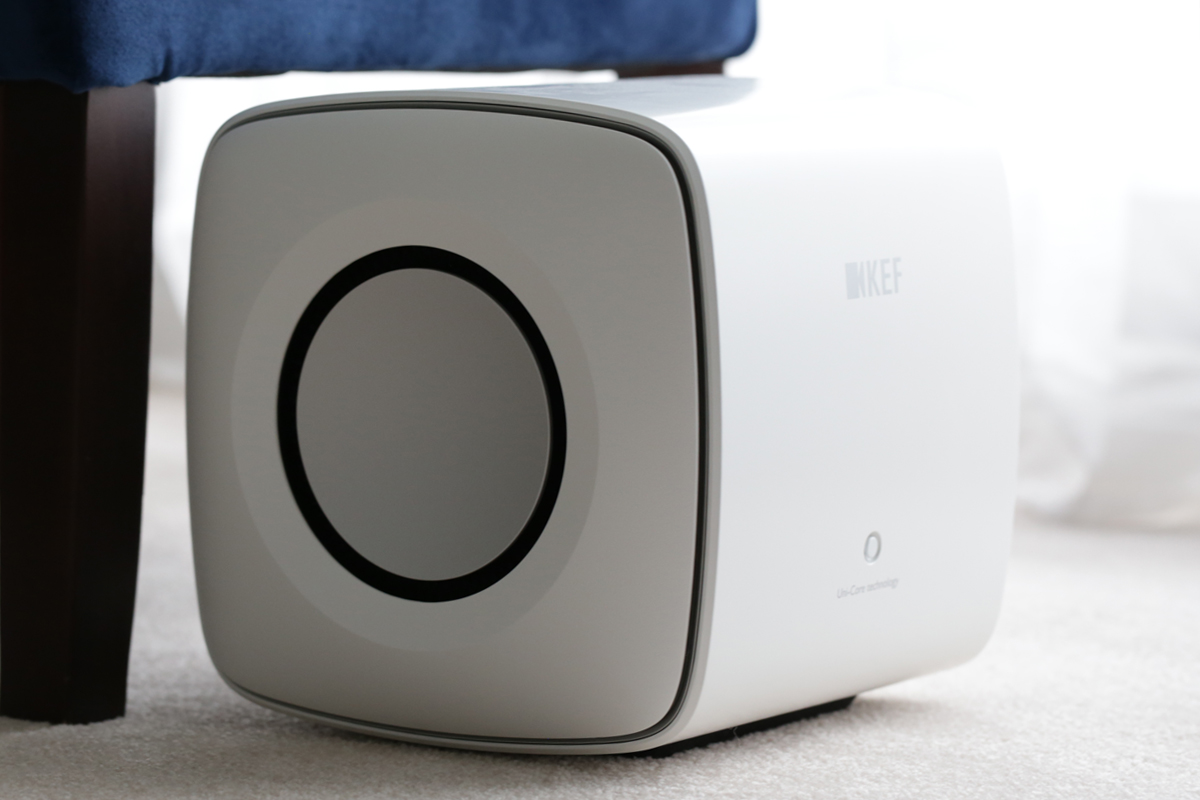
Again, there were benefits higher in the audioband. During the big wall-of-sound passages in the middle of the track, Latry’s giant chords were more clearly resolved with the subwoofer in the mix. The sound was a little more spacious, a little less congested.
Comparison I
I compared the KC62 with my SVS 3000 Micro subwoofer ($899.99), which employs two horizontally opposed 8″ aluminum drivers powered by a monaural amplifier specified to output 800W continuous and 2500W peak. As its name conveys, the 3000 Micro is also a compact design, though not as small as the KC62—it’s an inch or so bigger in each dimension. Placed next to the electric fireplace in our living room, its visual footprint was noticeably larger, but not hugely so.
The big bass note that opens “Flight of the Cosmic Hippo” sounded suitably loud and impressive with the SVS sub underpinning my Elacs, but not quite as powerful and effortless as it did when the KEF sub was augmenting the floorstanders. And that big note was not as tight or as well controlled as it was through the KC62. The same was true of the second part of Victor Wooten’s bass solo, played largely on the bottom string; it sounded woolier through the SVS sub, with slightly poorer pitch differentiation. Future Man’s synthesized kick drum also hit a little harder through the KC62 than it did through the 3000 Micro.
On the Rachmaninoff prelude from Midnight at Notre-Dame, Olivier Latry’s subterranean pedal notes sounded a little fainter through the SVS sub. On both subs, I felt those deep pipe-organ notes in my legs and torso. But those notes had noticeably more growl and texture through the KC62—through the 3000 Micro, they had more of a droning quality. With the SVS sub, the air did not throb with low-frequency energy the way it had with the KEF.
Setup II
For my second round of listening, I mated the KC62 with KEF’s LS50 Wireless II active minimonitors ($2799.99/pair)—which I’m sure is a more typical pairing than using it with active floorstanders like my ARF-51s. The LS50WII employs KEF’s Uni-Q driver, comprising a 5.25″ magnesium-aluminum midrange woofer powered by a 280W class-D amp and a concentrically mounted 1″ aluminum-dome tweeter powered by a 100W class-AB amp.
I placed the LS50WIIs on 28″ Monoprice Monolith speaker stands, with their rear panels 18″ from the wall behind them. The speakers were 7′ apart and 7′ from my listening position against the opposite wall.
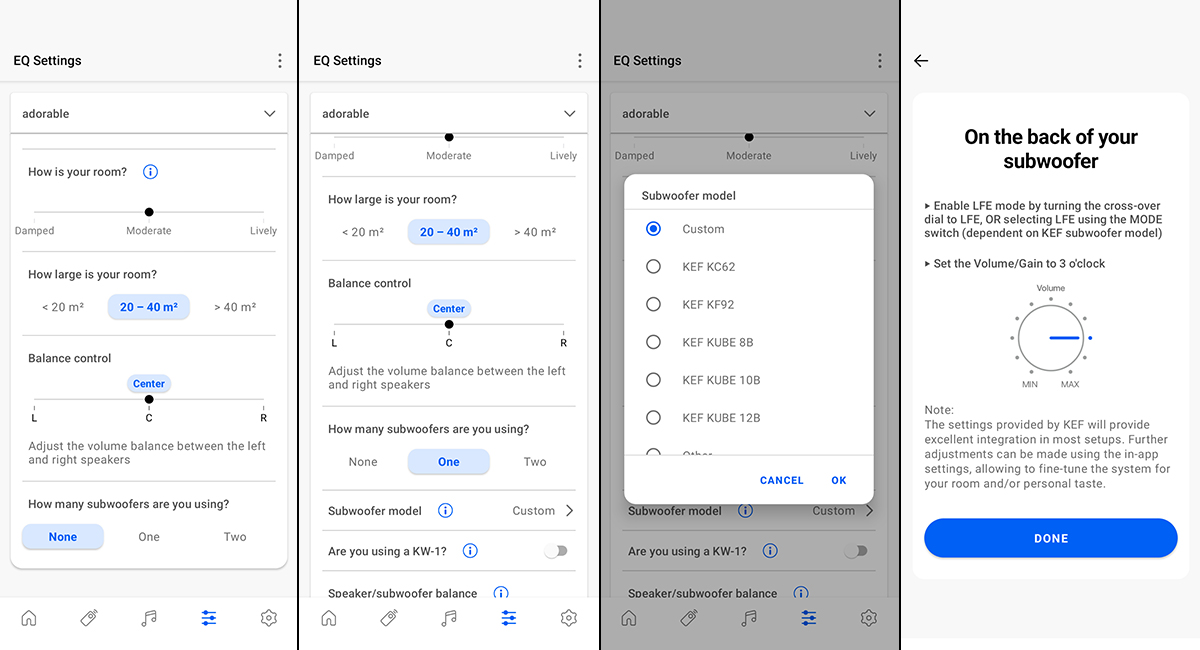
The first step was installing the KEF Connect app on my Google Pixel 4a smartphone so that I could get the LS50WII speakers connected to my home network. Then I connected the subwoofer output on the primary LS50WII to the LFE subwoofer input on the KC62. After that, I opened the EQ Settings menu in KEF Connect, and specified the use conditions: the size of my room; the distance from the front wall; that the speakers were mounted on stands, rather than on a desk; and that I was using a subwoofer.
If you’re matching the LS50WIIs to a KEF sub, you can select the model from a dropdown list. When I selected the KC62, the app instructed me to set the sub’s level control at 3 o’clock, as this would “provide excellent integration in most setups.” But with this setting, the KC62 overwhelmed my listening room with fat, boomy bass. So with the aid of sine-wave test tones, I adjusted the sub’s volume control until its output matched the main speakers. Again, I ended up with a setting of approximately 11 o’clock. I could also have adjusted the subwoofer level from the KEF Connect app.
Listening II
Now it was time to listen again. I started with another favorite track for assessing bass performance, “Regular Pleasures” by Patricia Barber, from her album Verse (16/44.1 ALAC, Premonition Records/Blue Note Records), which I streamed from my music library to the KEF speakers via Roon. Throughout this track, double bassist Michael Arnopol plays a big, bold bass line, mostly on the lower strings, and Joey Baron adds a huge bass-drum beat at the end of each bar. There’s lots going on here in the 32–64Hz octave.
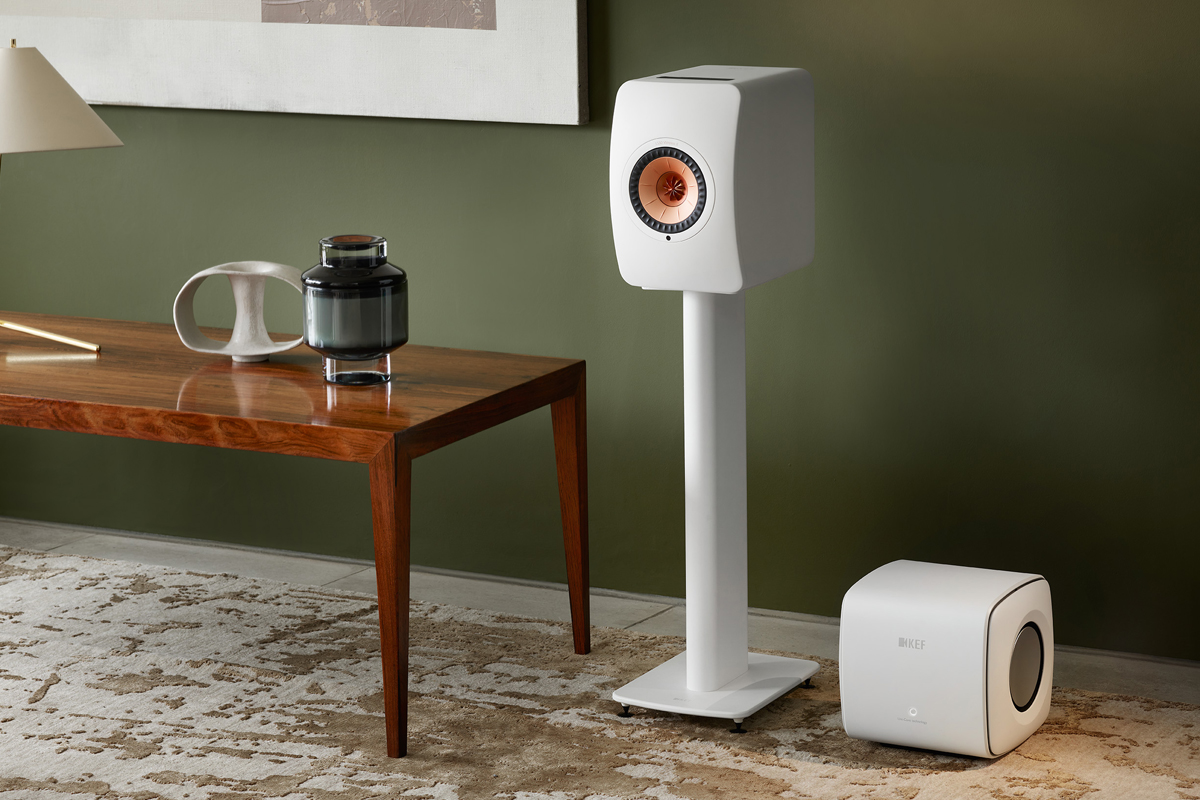
To establish a baseline, I first listened to this track through the LS50WIIs with the KC62 subwoofer turned off. It was very satisfying. Baron’s bass-drum thwacks and Arnopol’s double-bass riffs sounded imposing and resonant. That’s not surprising—the LS50WII’s specified frequency response is 48Hz–28kHz, ±3dB, in the speaker’s Standard bass mode. The lowest note of a four-string double bass, E1, is about 41Hz. So much of the bass content on “Regular Pleasures” lies within the LS50WII’s comfort zone.
Impressive as they sounded, those drumbeats and double-bass phrases weren’t perfect. There was some overhang—the drumbeats seemed to go on longer than they should; so did some double-bass notes. Some of Arnopol’s double-bass notes seemed louder than they should have, and others softer—levels were inconsistent depending on the pitch. While Arnopol’s pizzicato attacks on higher-pitch notes were crisp, those on lower notes were blurred. I’m sure those peaks and dips were the result of room modes in my listening room, not from the speakers themselves.
Next, I turned on the KC62 and enabled the LS50WII’s subwoofer output in the KEF Connect app, and played the same song again. Checking the signal path in Roon, I could see that with the KC62 connected, the LS50WII had implemented a high-pass filter at 70Hz for the main speakers. With the KC62 in the mix, Baron’s bass drum and Arnopol’s double bass sounded deeper and more powerful, but also more bloated. The little KEF subwoofer was making the bass modes in my listening room painfully obvious.
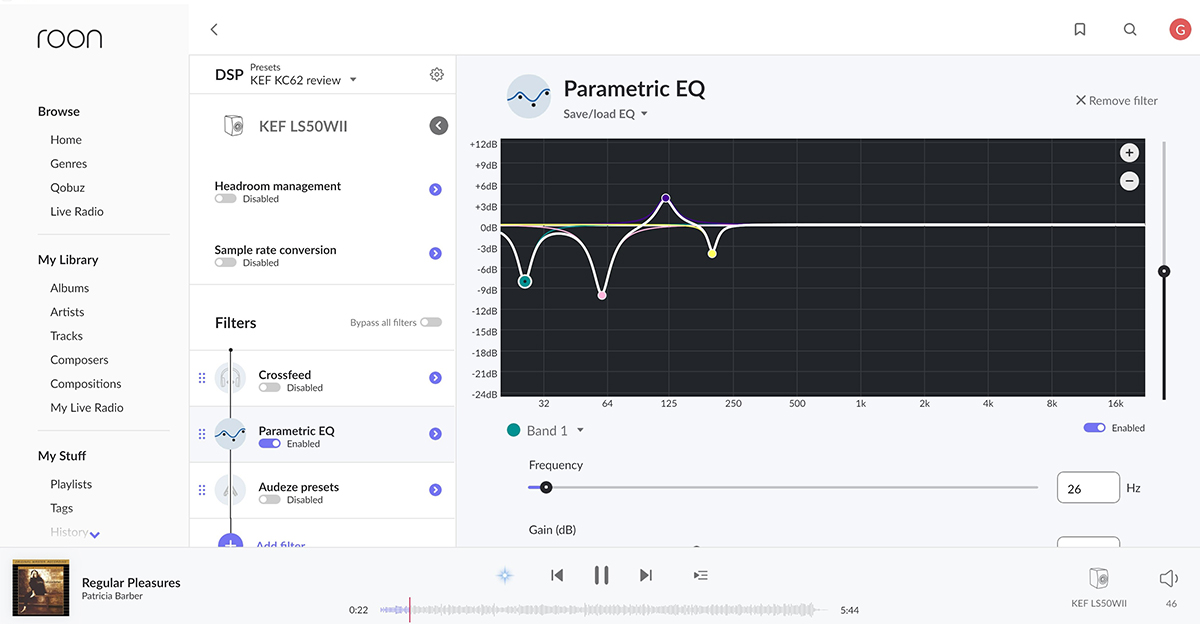
There was an easy fix. Using Roon’s DSP function, I implemented four bands of parametric EQ that roughly mirrored the peaks and dips I had identified with Dirac Live room correction during my first round of listening. This might seem like cheating, but it’s not. I wanted to experience—and write about—the KC62 subwoofer, not the uneven response of my listening room.
The result was transformational. At first, Baron’s bass drum and Arnopol’s double bass sounded less robust and powerful, but that was because the bloat had been banished. With Roon’s EQ settings enabled, each drumbeat had wonderful palpability and fabulous impact. Instead of one big boom, I heard the beat of the mallet against the drumhead, followed quickly by the resonance of the drum and the echoing decay of the drumbeat. Arnopol’s pizzicato double-bass attacks were much more defined, and sound levels were more consistent throughout the range of his instrument. The aural images of both instruments were more focused: Baron’s bass drum in the center rear of the soundstage, Arnopol’s double bass a little further forward and to the right.
Switching off the subwoofer and disabling those EQ settings, I could really appreciate how the KC62 was enhancing this track. Without the sub, Baron’s bass drum sounded muddier and less powerful, and Arnopol’s double bass was a little less full, with duller pizzicato attacks.
To hear what the KC62 could do with hip-hop, I cued up “Heartless,” from Kanye West’s 808s & Heartbreak (16/44.1 FLAC, Roc-A-Fella Records/Qobuz). The whole track is underpinned by deep, droning synth-bass notes. Those notes sounded big and powerful through the LS50WIIs without the sub, but they were boomy and indistinct.
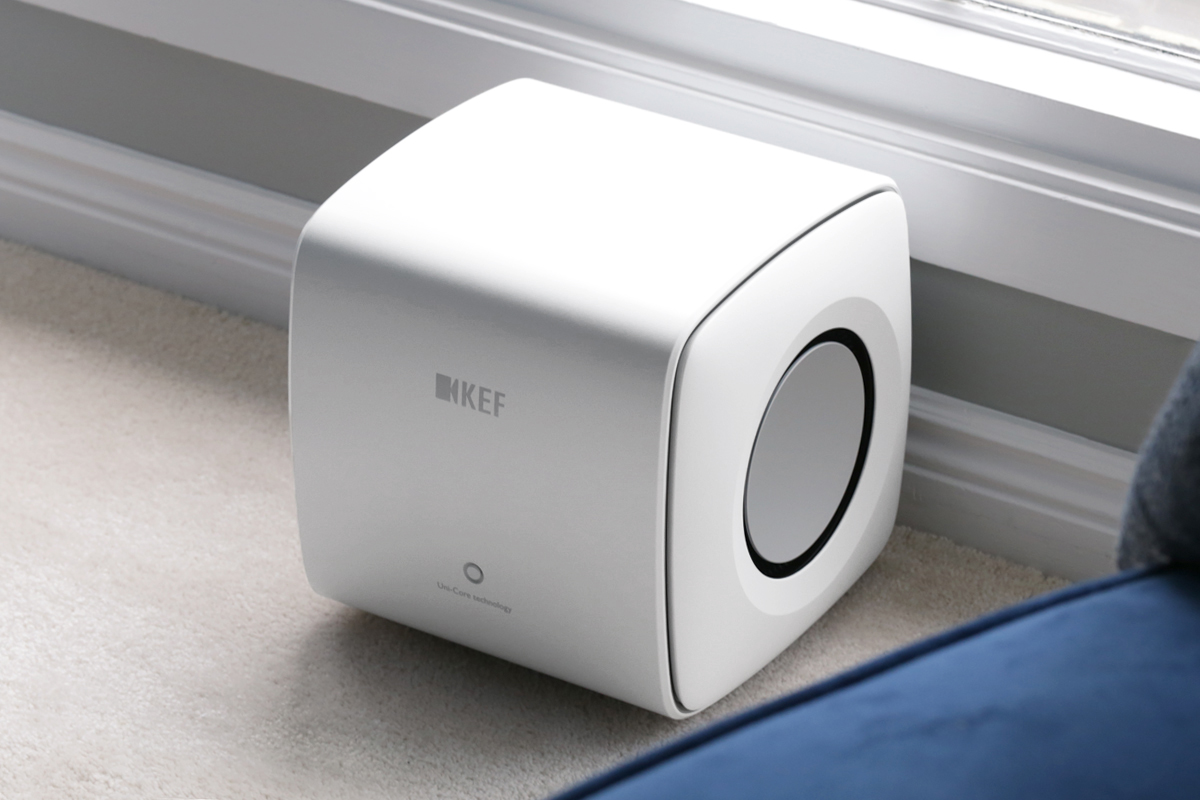
After switching in the KC62 and activating the EQ settings I had created in Roon, those synth-bass notes were less prominent, but far better controlled. Instead of an indistinct drone, I heard deep notes with discernable attacks. Pitch differentiation was greatly improved. With the sub in the mix, those pounding synth notes served more clearly as the heartbeat for the song. There was less congestion higher in the audioband, likely because the LS50WII’s 5.25″ drivers weren’t having to produce the deep fundamentals of the notes.
Comparison II
Again, I replaced the KC62 with my SVS 3000 Micro. Using a 40Hz sine-wave test tone, I matched the output of the SVS sub to the same level as the KEF. When comparing the subs, I enabled the EQ settings in Roon to counteract room modes in my living room.
On “Heartless,” the deep synth notes didn’t pound quite as hard through the SVS sub as they had through the KEF. On “Regular Pleasures,” Joey Baron’s big bass drumbeats had less slam. Those drumbeats sounded a little less powerful, and the initial attacks of mallet on drumhead weren’t as clearly defined. Similarly, Michael Arnopol’s pizzicato attacks on double bass weren’t quite as sharp.
Frankly, I’m not surprised by these differences. While its outer dimensions are smaller than the 3000 Micro’s, the KC62 is nearly 40% heavier, which indicates a more robust motor structure. As mentioned earlier, the specified frequency response for the KC62 is 11–200Hz, ±3dB, compared to 23–240Hz, ±3dB, for the 3000 Micro. So, according to these specs, the bass extension of the KC62 is a full octave greater than the 3000 Micro’s.
There’s another difference worth noting. With the SVS app, you can apply three bands of parametric EQ to the 3000 Micro’s response. When I’m not able to use Dirac Live room correction, I’ve found this feature very useful for counteracting the worst peaks in my listening room. The KEF Connect app and the KC62 don’t have this feature. If you want to smooth out room response with the KC62, you have to use a source with room correction, such as my NAD C 658, or apply EQ in an application like Roon.
Otherwise, I preferred the KC62. Visually, it disappeared more completely into my listening room (though the 3000 Micro also does a pretty good disappearing act). Sonically, the KC62 had greater bass extension and more slam. Of course, the KC62 should sound better—it costs 67% more than the 3000 Micro, which is a dynamite little subwoofer for its price.
Conclusion
Most subwoofers are big black boxes—fine for a dedicated listening room or home theater, but less suitable for a setting like the living room in our 1920s urban rowhouse. But tucked away beside the electric fireplace, the KC62 looked like it belonged—when I noticed it. Visually, the KC62 didn’t call attention to itself, but if I did look at it, I really liked what I saw.

And I loved what I heard. Throughout my listening, the KC62 filled my room with deep, well controlled, high-output bass. Can Hofmann’s Iron Law be bent any further than KEF has managed with the KC62? I doubt it—but who knows? What I do know is that the KC62 is an engineering and sonic tour de force.
. . . Gordon Brockhouse
Associated Equipment
- Active loudspeakers: KEF LS50 Wireless II, Elac Navis ARF-51.
- Subwoofer: SVS Audio 3000 Micro.
- Streaming DAC-preamp: NAD C 658.
- Speaker stands: Monoprice Monolith 28″.
- Sources and control devices: Apple iPhone 8 and Google Pixel 4a 5G smartphones, Apple Mac Mini (mid-2011) running Roon Core 1.8, HP Spectre x360 Windows PC running Roon Control 1.8.
- Network: Google Wifi four-node mesh network.
KEF KC62 Powered Subwoofer
Price: $1499.99.
Warranty: Five years, parts and labor; active electronics, one year.
KEF
GP Acoustics (UK) Ltd.
Eccleston Road, Tovil
Maidstone
Kent ME15 6QP
United Kingdom
Phone: +44 (0)1622-672261
Fax: +44 (0)1622-750653
Email:
Website: www.kef.com
North America:
KEF
GP Acoustics (US) Ltd.
10 Timber Lane
Marlboro, NJ 07746
United States
Phone: (732) 683-2356
Fax: (732) 683-2358
Email:
Website: www.kef.com/us
